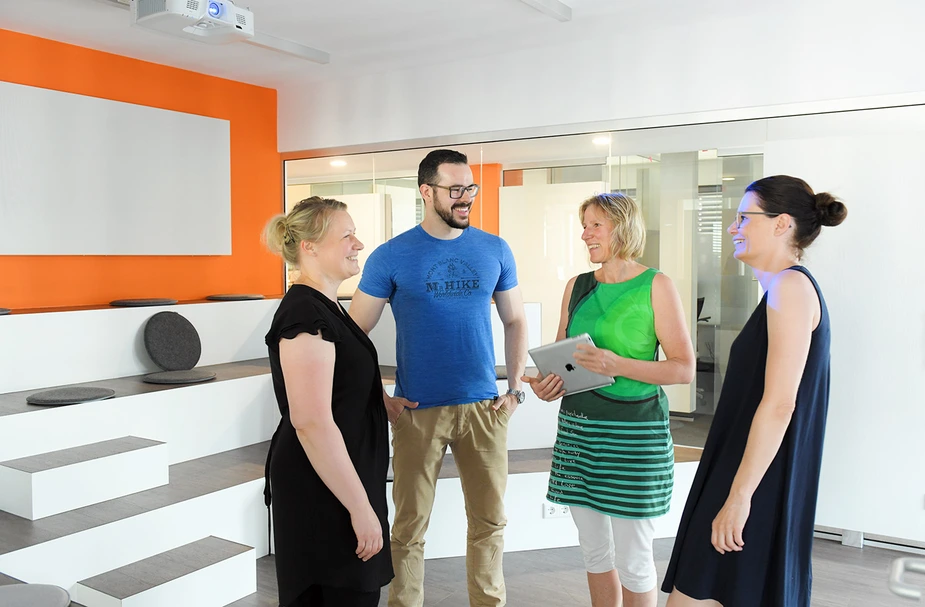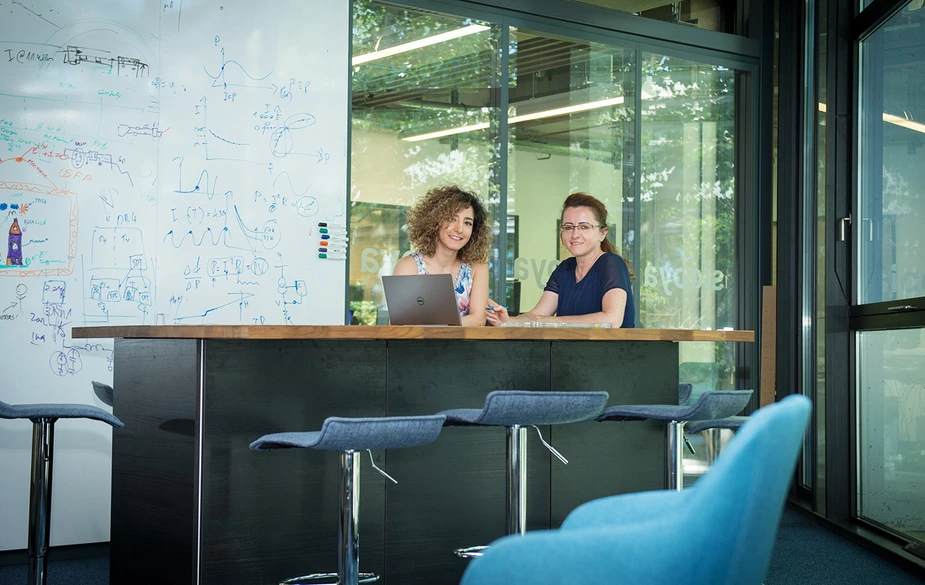Workplaces of the future
What will they look like in Adlershof?
Companies like LUMITOS AG, Sicoya GmbH and kba Architekten und Ingenieure know that ensuring well-being at the workplace and creating spaces for creativity and teamwork are indispensable in today’s work environment. A key issue for them is to attract and retain highly skilled employees. We asked these three Adlershof-based companies how they are shaping the future of the workplace.
ACTIVITY-BASED WORKING
At LUMITOS AG, twenty-three employees are working in an entirely new work environment. The buzzword here is activity-based working. Working in online marketing for scientific and medical businesses, the company employs marketing experts and natural scientists. Instead of classic offices and individual workspaces, the company’s brand-new headquarters is made up of areas assigned to different tasks. They include a long pin board, a lounge with a kitchen in the middle, huddle spaces, individual work alcoves, meditation rooms, and a large conference room. The latter resembles a university lecture hall but with steps and seat cushions. Stefan Knecht, managing director of Lumitos, has been dealing with ‘new work’ for a long time. His motivation is not to save money but ‘to reflect on the task I’m currently working on. Is it creative, do I need my colleagues, or do I need some peace and quiet? This way of working is very efficient. I consciously decide to do what I have to do next. That’s the heart of the matter here.’ Together with his employees, he has been working on the new workplace layout for five months. Making the change from a classic work environment was not always easy.
‘You have to invest a lot of time into your team and strengthen the process.’ Knecht is not a fan of the cubicled corporate office. The noise level is bad for communication, he says, and scientific studies have confirmed that. The concept of activity-based working, which has been around since the 1970s, might be more expensive at first, but is more beneficial in the long term. Lumitos would have required more than 200 additional square metres to house a traditional office space.
However, the workplace of the future is not only about floorplans. Stefan Knecht’s openness and curiosity have also resulted in a range of different workhour models. ‘The nine-to-five model is a dying breed. The new challenge is to balance work and private life. If a company wants the best possible employees, it has to be flexible.’ Lumitos have been offering work-from-home days and flexible work hours for a long time.
GO TO WORK AND GO FOR A RUN
A sunlit stairwell, wide corridors, large glass windows, and warm colours; classic offices with two or four desks; two rooftop terraces with comfortable furniture. To David Lehmann and Thomas Wilding, the two CEOs of the architecture firm kba, this feels just like home. In fact, it is their second home. Lehmann, a business administration graduate, does not beat around the bush: ‘Nowadays, a workplace has to be attractive. It has to factor in well-being and a certain coolness.’ However, everyone here has their own desk. This is also valued by the staff.
The creative architecture area is on the first floor, where everyone can form groups and huddle together as they need it. This is good for working on projects. ‘Noise is a great disadvantage. We tried very hard to improve the acoustic design of our office. Large open-plan offices are not always the best solution.’ He prefers focusing on specific tasks and on supporting those processes. This can result in, for example, a group office for group tasks, or an individual office for individual tasks. The office also has a remote workplace. ‘Starting in June, we are introducing a flexible time management model. Between 6am and 10pm, our staff can work as they wish based on their project’s requirement.’
Since the early 1990s, kba has been working on refurbishing and constructing buildings and offices, for example, the Innovation and Start-Up Centre (IGZ). In 2008, they became one of the few architecture companies in Adlershof and moved into their new headquarters in Wagner-Régeny-Straße. ‘We are currently drawing up plans for a large advertising agency from Kreuzberg that is moving to Adlershof. Interestingly, these guys are high-end creatives who work in a fairly conventional environment.’
Moreover, the kba staff is taking part in Adlershof’s company run with four teams in September. They are training for the event every week. They do so at the next-door landscaped park, which is also a contributing factor to workplace well-being.
TEAM MEMBERS FROM TEN DIFFERENT NATIONS
The Photonics Centre on Carl-Scheele-Straße resembles an amoeba. ‘We find it fitting to work in a house without corners. It’s great for communicating with each other. Let me give you an example: our engineers work in an open-plan area, so as many things as possible can be settled through personal interaction,’ says Carmen Fritz-Heyer, who is the human resource manager at Sicoya GmbH. The company develops and produces optical transceiver solutions for 400 GB/s data centres based on silicon photonics. The fast-growing company designed its headquarters to match its own requirements around two open-plan offices. These also include conference rooms and several smaller, quieter rooms for more focused activities. Each staff member has their own desk but no fixed computers, instead they have take-home laptops for increased flexibility. Employees may work anywhere in the building, or work from home if, say, they must take care of a sick child, or traffic chaos prevents them from coming in.
Sicoya moved to Adlershof in 2017. CEO Sven Otte says: ‘Adlershof’s great infrastructure really matches our needs in terms of manufacturing as well as networking. Since we are growing every year, it is important to us that our location provides ample space for growth. Our work culture is based on openness and we don’t want physical limitations to hinder communication.’ In September, the team have grown to 85 people. The next step is a new headquarters; Adlershof would be ideal.
At Sicoya, too, well-being is an important factor. Water, soft drinks, fruit and vegetables, but also pizza is available to the staff for free. ‘We want our employees to feel at home,’ says Carmen Fritz-Heyer and her marketing assistant Nazanin Deheshtnia. After all, the company is made up of people from ten different nations. In-house, full-pay German courses are part of this culture which will soon be complemented by English courses and weekly sporting events. ‘We also host regular parties. Particularly our non-German employees really value this sense of togetherness, one that is open to their families, too.’ A night of socialising and barbecuing around a fire is a tradition at Sicoya – and yet another advantage of a place like Adlershof.
By Jördis Götz for Adlershof Journal


